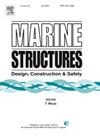Probabilistic demand models and analytical fragility quantification for ship hulls under ultimate bending conditions
IF 5.1
2区 工程技术
Q1 ENGINEERING, CIVIL
引用次数: 0
Abstract
Fragility analysis is a key performance assessment approach that quantifies the structural performance under a wide spectrum of possible hazard intensities. Fragility profiles can be established for a particular vessel using simulation techniques. However, simulation-based fragility assessment of ship hulls is computationally intensive, and its applicability is limited to the investigated vessel. In contrast, analytical fragility models provide a computationally efficient alternative allowing for wider applicability to cover a particular class of vessels. This paper proposes a novel framework for developing analytical fragility profiles for hulls of a specific vessel class considering ultimate bending conditions. The framework includes the development of probabilistic demand models needed to estimate the statistical characteristics of the engineering demand parameters based on the ship main particulars and hazard intensity measures. Nonlinear regression analysis, using constrained nonlinear optimization algorithms, is conducted to estimate the parameters of the proposed models. The framework is demonstrated on tankers, where probabilistic demand measures for five double-hull tankers are quantified while accounting for uncertainties in the applied loads and their combination factors. The capacity thresholds, representing the maximum demand a vessel can withstand before reaching a specific damage state, are then quantified probabilistically. Analytical fragility profiles are then established and validated against simulation-based fragility results obtained using artificial neural network-assisted finite element simulation. The results show that the developed probabilistic demand models can effectively estimate the statistical descriptors of the demand measure, and the established framework provides a highly computationally efficient alternative to simulation-based fragility assessment.
船体在极限弯曲条件下的概率需求模型和分析脆性量化
脆弱性分析是一种关键的性能评估方法,它可以量化结构在各种可能的危险强度下的性能。使用模拟技术可以建立特定船舶的易损性剖面。然而,基于仿真的船体易损性评估计算量大,其适用性仅限于被调查船舶。相比之下,分析脆弱性模型提供了一种计算效率高的替代方案,允许更广泛的适用性,以覆盖特定类别的船舶。本文提出了一种新的框架,用于开发考虑极限弯曲条件的特定船型船体的分析易损性剖面。该框架包括基于船舶主要特征和危害强度度量来估计工程需求参数的统计特征所需的概率需求模型的开发。采用约束非线性优化算法进行非线性回归分析,估计模型的参数。该框架在油轮上进行了演示,其中量化了五艘双壳油轮的概率需求度量,同时考虑了施加载荷及其组合因素的不确定性。容量阈值代表船舶在达到特定损坏状态之前可以承受的最大需求,然后以概率量化。然后,根据人工神经网络辅助有限元模拟获得的基于仿真的脆性结果,建立并验证分析脆性剖面。结果表明,所建立的概率需求模型能够有效地估计需求测度的统计描述符,所建立的框架为基于仿真的脆弱性评估提供了一种计算效率很高的替代方案。
本文章由计算机程序翻译,如有差异,请以英文原文为准。
求助全文
约1分钟内获得全文
求助全文
来源期刊

Marine Structures
工程技术-工程:海洋
CiteScore
8.70
自引率
7.70%
发文量
157
审稿时长
6.4 months
期刊介绍:
This journal aims to provide a medium for presentation and discussion of the latest developments in research, design, fabrication and in-service experience relating to marine structures, i.e., all structures of steel, concrete, light alloy or composite construction having an interface with the sea, including ships, fixed and mobile offshore platforms, submarine and submersibles, pipelines, subsea systems for shallow and deep ocean operations and coastal structures such as piers.
 求助内容:
求助内容: 应助结果提醒方式:
应助结果提醒方式:


